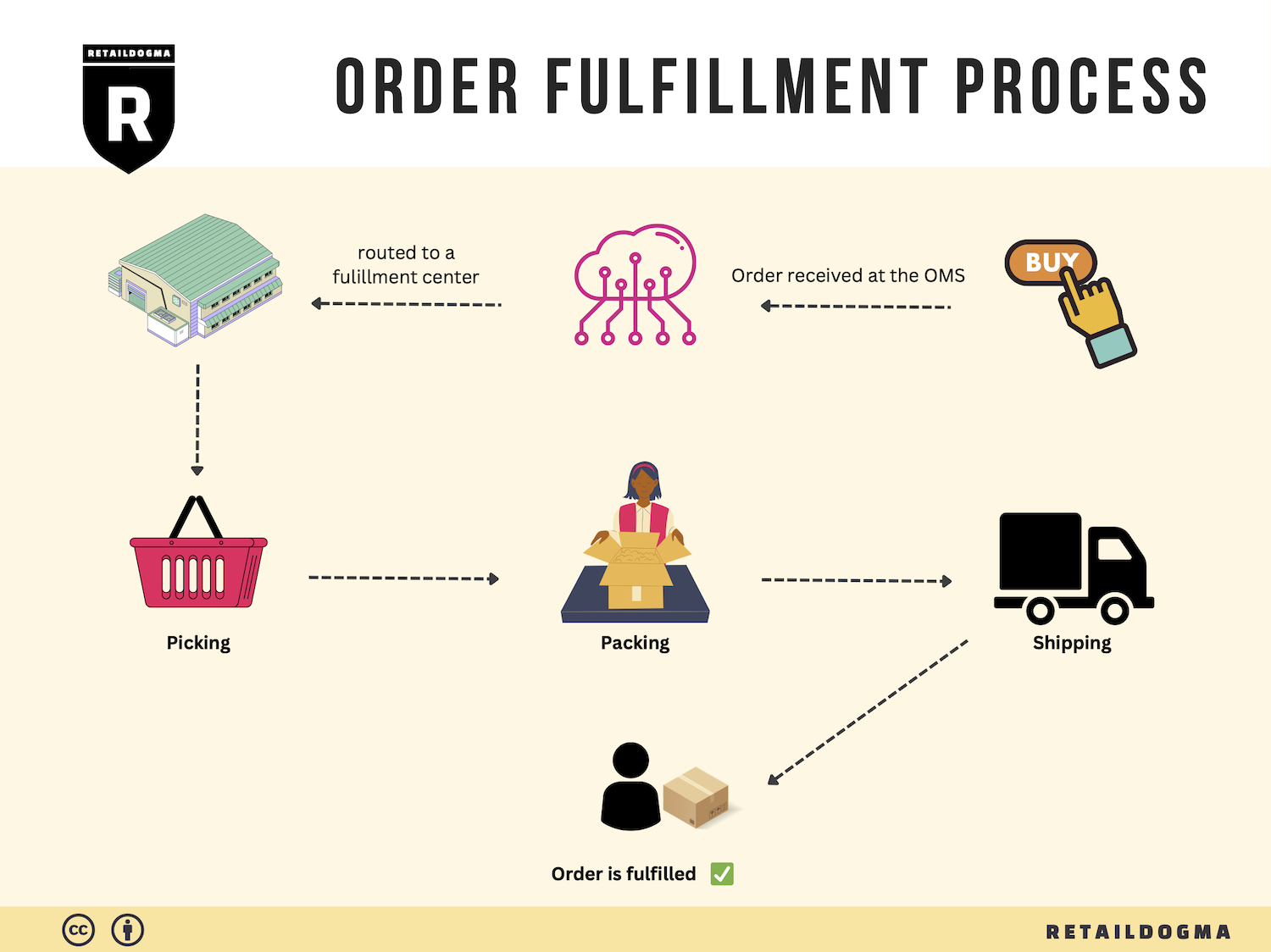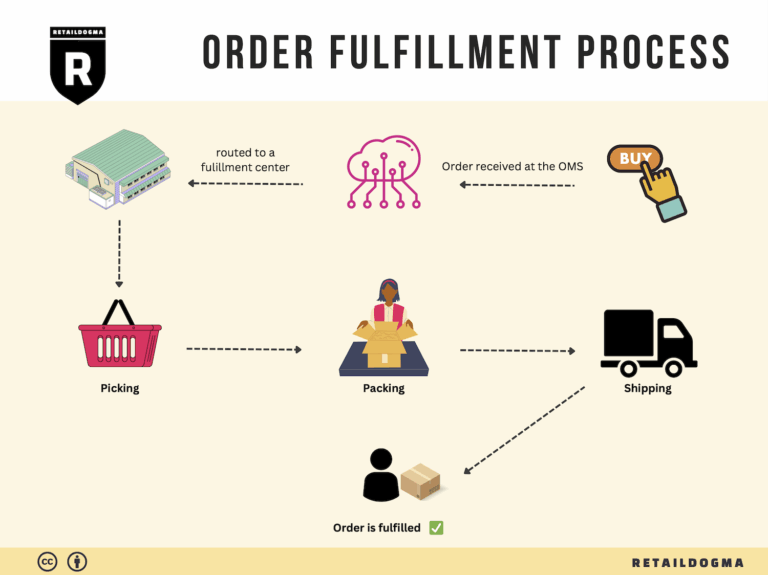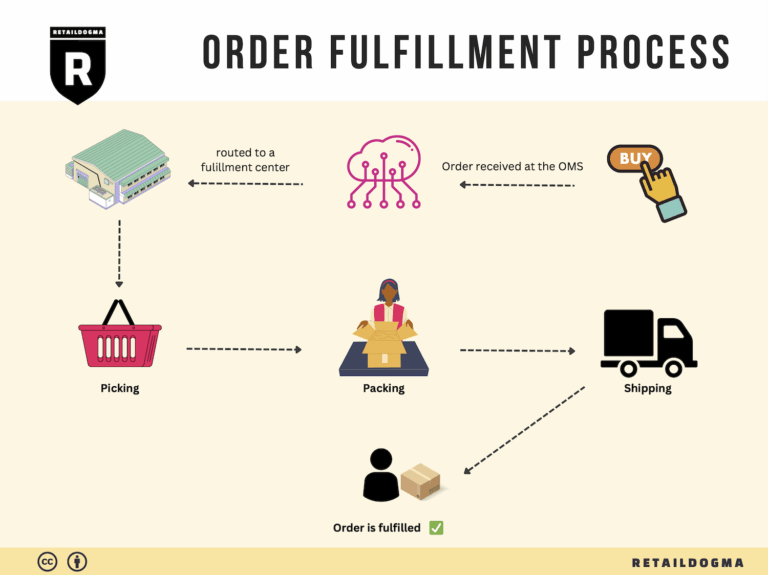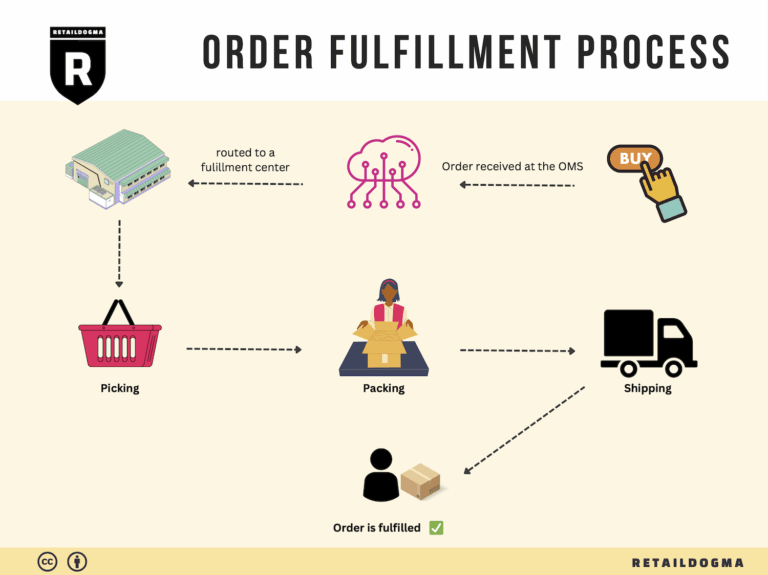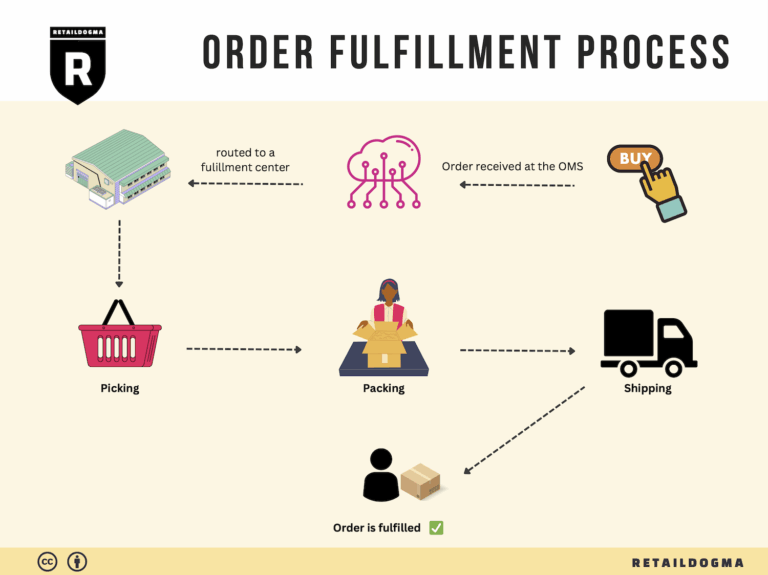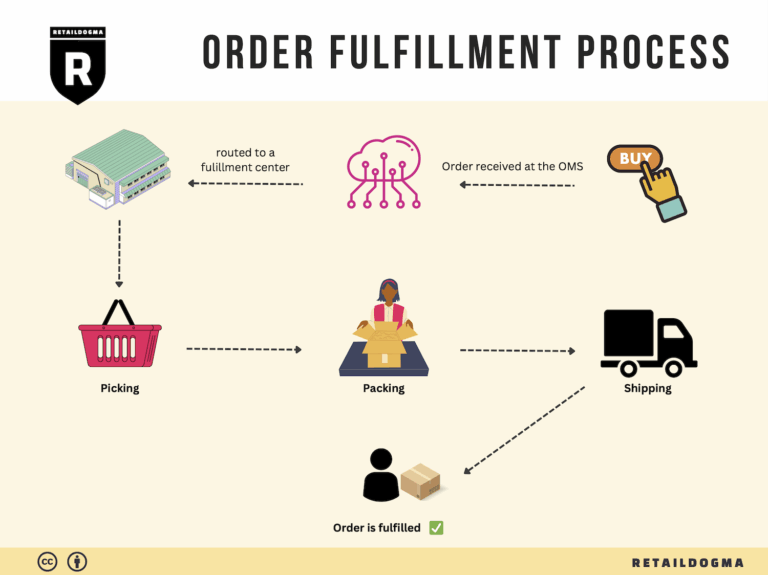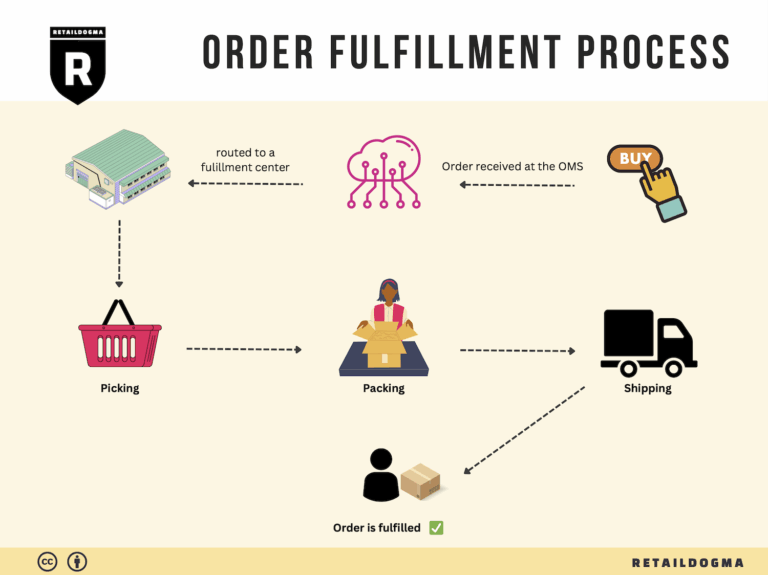What Is A Fulfillment Center? A Complete Guide (2025)
What is E-commerce Fulfillment? An Introduction for Growing Businesses
Navigating the Challenges of Order Fulfillment
As an e-commerce business owner, you may find yourself grappling with the overwhelming tasks of packing and shipping orders. The rapid growth of your online store often leads to increased demand, and with that comes the complexity of efficiently fulfilling those orders. This challenge can distract you from focusing on other critical aspects of your business, such as marketing and customer engagement.
Understanding fulfillment is key to alleviating this burden. At its core, fulfillment is the process of getting a product from your inventory to your customer’s doorstep. This includes everything from receiving and storing products to picking, packing, and shipping them. As your business scales, mastering this process becomes essential for maintaining customer satisfaction and operational efficiency.
In this guide, we will delve into various fulfillment models that can cater to your growing business needs. We will explore Third-Party Logistics (3PL) providers, which handle your storage, packing, and shipping, allowing you to focus on core business functions. Additionally, we will discuss Fulfillment by Amazon (FBA), a popular option for e-commerce sellers that leverages Amazon’s extensive logistics network to streamline order fulfillment.
You will also learn about the core services that fulfillment partners typically offer, including inventory management, order processing, returns handling, and customer support. These services are critical for ensuring that your logistics operations run smoothly and meet customer expectations.
Choosing the right fulfillment partner can be daunting, but it’s a decision that can significantly impact your bottom line. This guide will provide insights into how to evaluate potential partners, considering factors such as location, technology, scalability, and customer service.
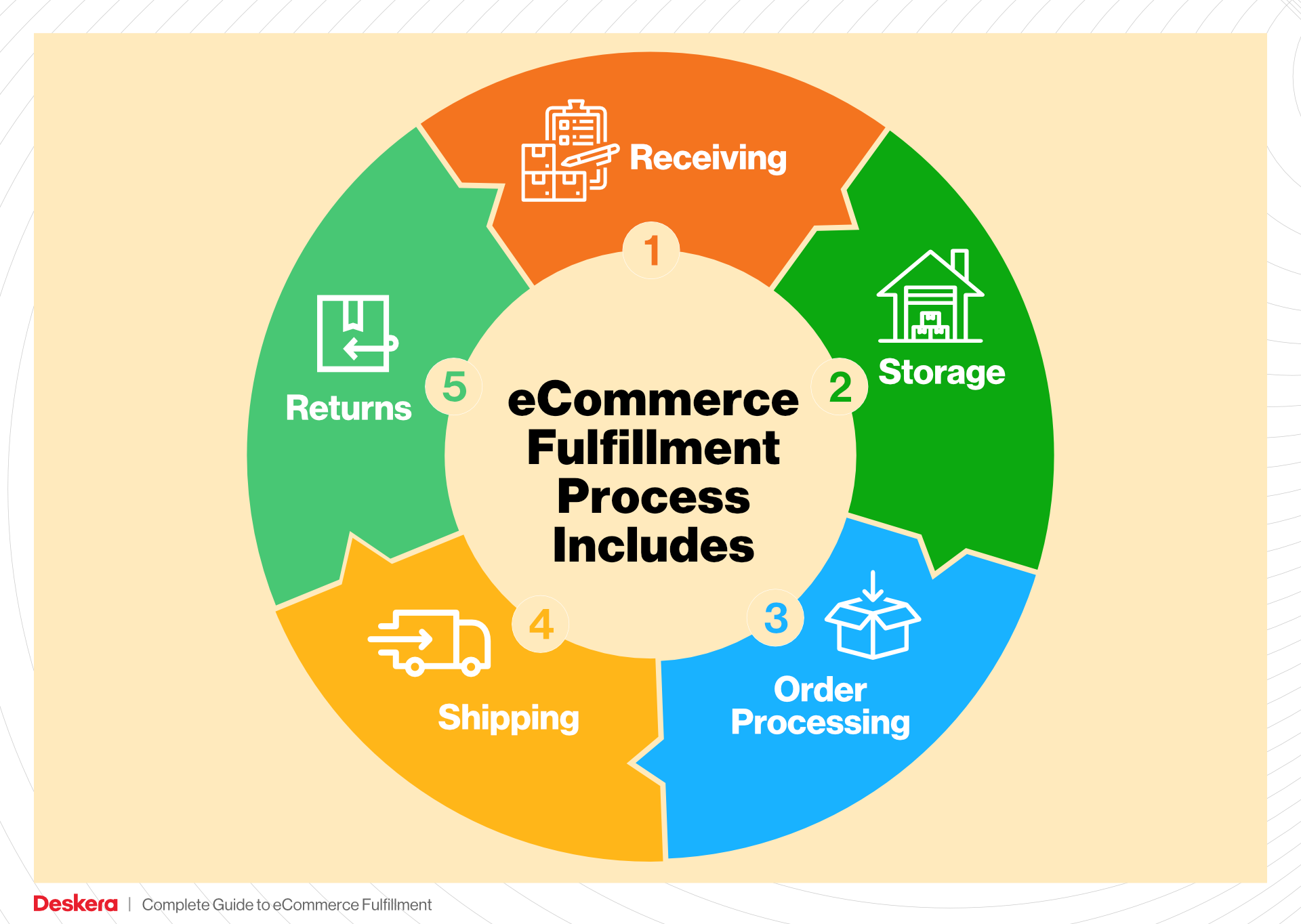
Finally, we will address pricing structures within the fulfillment landscape. Understanding how fulfillment costs are calculated—whether based on storage space, order volume, or shipping methods—will empower you to make informed financial decisions that align with your business goals.
Our aim is to equip you with the knowledge needed to make smart decisions regarding your logistics strategy. By the end of this guide, you will have a clearer understanding of e-commerce fulfillment and how to effectively scale your operations while enhancing customer satisfaction.
What You’ll Learn In This Guide
- What is E-commerce Fulfillment? An Introduction for Growing Businesses
- The Order Fulfillment Process: From ‘Buy’ Button to Customer’s Door
- Comparing Fulfillment Models: In-House vs. 3PL vs. Dropshipping
- A Deep Dive into Amazon FBA: Pros, Cons, and Who It’s For
- Core Services Offered by Fulfillment Centers
- How to Choose a Fulfillment Partner: A 6-Point Checklist
- Understanding Fulfillment Pricing: A Breakdown of Common Fees
- Frequently Asked Questions (FAQs) about Fulfillment
- Conclusion: Is Outsourcing Fulfillment the Right Move for Your Business?
- Important Disclaimer
The Order Fulfillment Process: From ‘Buy’ Button to Customer’s Door
1. Receiving Inventory
The order fulfillment process begins with receiving inventory at the fulfillment center. This step involves the inspection and logging of incoming products into the warehouse management system (WMS). During this phase, items are checked for accuracy against purchase orders, ensuring that the right products and quantities are received.
Importance: Proper inventory receiving is crucial for maintaining accurate stock levels and preventing discrepancies that can lead to stockouts or overstock situations. Accurate inventory data is essential for effective order management and customer satisfaction.
Key Term: SKU (Stock Keeping Unit) – This unique identifier for each product variant allows for precise tracking and management of inventory. By associating each SKU with its corresponding product information, businesses can streamline their inventory processes.
2. Warehouse Storage
After receiving, the next step is warehouse storage, where products are organized within the fulfillment center. This involves placing items in designated storage locations, which can include shelves, pallets, or bins, based on factors such as product size, weight, and turnover rate.
Importance: Efficient warehouse storage maximizes space utilization and facilitates easy access to products during the order fulfillment process. Well-organized storage helps reduce retrieval times, which is essential for meeting customer expectations for fast delivery.
Key Term: ABC Analysis – This inventory categorization technique helps prioritize stock based on value and turnover rate, allowing businesses to allocate resources effectively and optimize storage strategies.
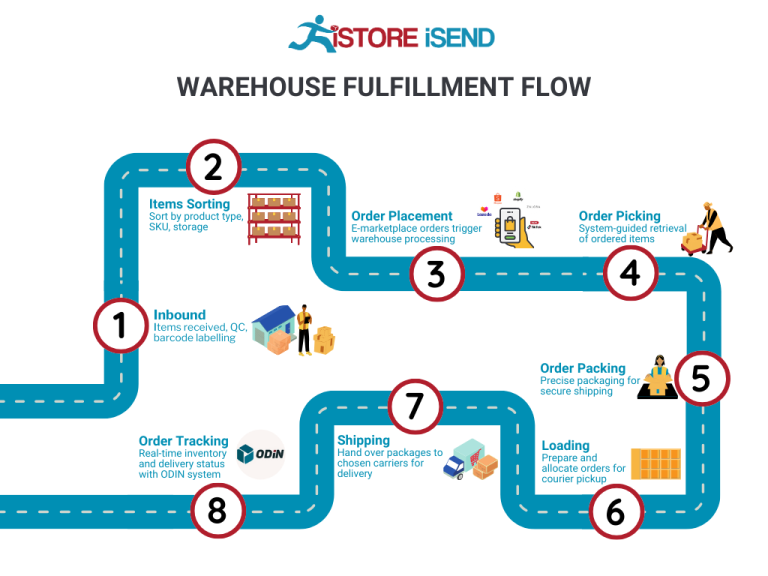
3. Order Picking
Once an order is placed, the order picking process begins. This involves retrieving the items from their storage locations based on the order details. Warehouse staff or automated systems create pick lists that specify which items need to be collected and their respective locations.
Importance: Efficient order picking is vital for ensuring that customers receive the correct products quickly. The speed and accuracy of this step directly impact customer satisfaction and retention. A streamlined picking process can significantly reduce order processing time.
Key Term: Pick List – This document or digital display guides warehouse personnel in selecting the correct items for an order, ensuring accuracy and efficiency in retrieval.
4. Order Packing
After items are picked, they move to the order packing stage. In this step, products are carefully packaged to ensure they are secure during transit. Packaging materials, such as boxes, bubble wrap, and packing peanuts, are selected based on the nature of the items being shipped.
Importance: Proper packing is critical for preventing damage during shipping, which can lead to returns and dissatisfied customers. Additionally, effective packing can reduce shipping costs by minimizing the size and weight of packages.
Key Term: Packing Slip – This document accompanies the package and lists the contents of the order. It serves as a reference for both the customer and the fulfillment center, ensuring transparency and accuracy.
5. Shipping & Delivery
The final step in the order fulfillment process is shipping and delivery. Once the order is packed, it is labeled and sent to the shipping carrier, which transports the package to the customer’s location. Businesses often provide tracking information to customers, allowing them to monitor their shipment’s progress.
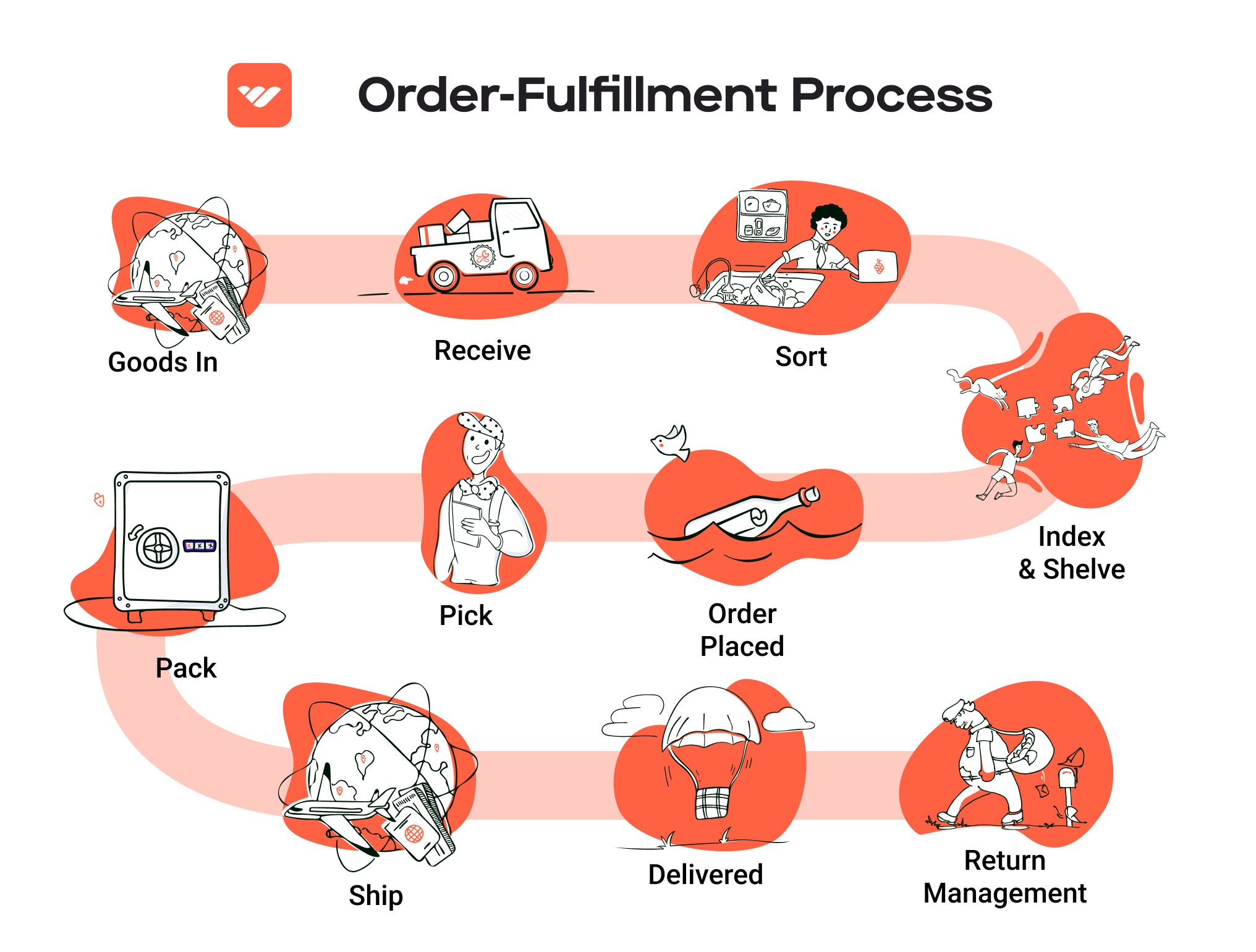
Importance: Timely shipping and delivery are essential for meeting customer expectations and maintaining a positive shopping experience. Delays in this phase can lead to frustration and negatively impact a business’s reputation.
Key Term: Last-Mile Delivery – This term refers to the final leg of the shipping journey, where the package is delivered from a distribution center to the customer’s doorstep. Optimizing last-mile delivery is crucial for enhancing customer satisfaction and reducing delivery costs.
By understanding and optimizing each step of the order fulfillment process, e-commerce businesses can enhance efficiency, improve customer satisfaction, and ultimately scale their operations successfully. Each phase plays a vital role in creating a seamless experience that can set a brand apart in a competitive marketplace.
Comparing Fulfillment Models: In-House vs. 3PL vs. Dropshipping
Fulfillment Model Comparison
| Model | Who Handles Inventory | Best For (Business Stage) | Key Advantage | Key Disadvantage |
|---|---|---|---|---|
| In-House Fulfillment | Business Owner | Established businesses with stable sales | Complete control over inventory and fulfillment processes | High overhead costs and operational complexity |
| Third-Party Logistics (3PL) | 3PL Provider | Growing businesses seeking scalability | Access to expertise and resources without the need for investment | Less control over inventory and potential communication challenges |
| Dropshipping | Supplier/Manufacturer | Startups or businesses testing new products | Low initial investment and minimal risk | Lower profit margins and reliance on supplier reliability |
In-House Fulfillment
In-house fulfillment is a model where the e-commerce business manages its own inventory, warehousing, and shipping operations. This approach is typically favored by established businesses that have a steady sales volume and can afford the overhead costs associated with managing their logistics. The primary advantage of in-house fulfillment is the level of control it offers. Businesses can directly oversee inventory management, quality control, and shipping processes, ensuring that customer expectations are consistently met. This model also allows for the implementation of tailored fulfillment strategies that align closely with the brand’s values and customer service standards.
However, the in-house fulfillment model comes with significant drawbacks. Operating a warehouse requires substantial capital investment in infrastructure, technology, and staffing. Additionally, businesses must manage the complexities of logistics, which can divert focus from core business activities such as marketing and product development. As sales volumes fluctuate, maintaining an in-house fulfillment operation can lead to inefficiencies and increased costs, particularly for businesses that experience seasonal sales spikes or downturns.
Third-Party Logistics (3PL)
Third-party logistics (3PL) refers to outsourcing the logistics and fulfillment processes to a specialized provider. This model is particularly beneficial for growing businesses that are seeking to scale their operations without the burdens of managing a warehouse and logistics themselves. A 3PL provider typically offers a range of services, including inventory management, order fulfillment, shipping, and returns processing, allowing businesses to focus on their core competencies.
The key advantage of using a 3PL is the access to expertise and resources that would be expensive and time-consuming to develop in-house. 3PL providers often have established relationships with shipping carriers, technology platforms, and logistics networks that can enhance efficiency and reduce shipping costs. Additionally, businesses can easily scale their operations up or down based on demand fluctuations, minimizing the risks associated with overcapacity or underutilization.
On the downside, reliance on a 3PL can lead to challenges in communication and control over the fulfillment process. Businesses may find it difficult to maintain their brand’s service standards if the 3PL does not align with their operational philosophy. Moreover, any issues that arise with the 3PL, such as service failures or inventory discrepancies, can directly impact customer satisfaction and brand reputation.
Dropshipping
Dropshipping is a fulfillment model where the retailer does not keep goods in stock but instead transfers customer orders to a third-party supplier or manufacturer, who then ships the products directly to the customer. This model is particularly appealing to startups and businesses testing new products, as it requires minimal upfront investment and allows for a wide product range without the risks associated with unsold inventory.
The most significant advantage of dropshipping is the low barrier to entry. Entrepreneurs can start an e-commerce business with little capital, as they do not need to invest in inventory or warehouse space. This model also provides flexibility in terms of product offerings and can facilitate rapid market testing and iteration. Additionally, since the retailer is not involved in the warehousing and shipping processes, they can concentrate on marketing and customer engagement.
However, dropshipping also has notable disadvantages. One of the primary concerns is the lower profit margins, as retailers must share profits with suppliers. Furthermore, the reliance on suppliers means that the retailer has less control over inventory levels, shipping times, and product quality. Any delays or errors on the supplier’s part can lead to customer dissatisfaction and damage the retailer’s reputation. Additionally, effective customer service can be challenging, as the retailer may not have firsthand knowledge of inventory and shipping processes.
Conclusion
When selecting a fulfillment model, e-commerce business owners must carefully consider their operational goals, financial resources, and customer expectations. Each model—whether in-house fulfillment, 3PL, or dropshipping—offers unique advantages and challenges that can significantly impact scalability and customer satisfaction. By understanding the nuances of each model, businesses can make informed decisions that align with their growth strategies and operational capabilities.
A Deep Dive into Amazon FBA: Pros, Cons, and Who It’s For
Understanding Fulfillment by Amazon (FBA)
Fulfillment by Amazon (FBA) is a service offered by Amazon that allows e-commerce sellers to store their products in Amazon’s fulfillment centers. Amazon takes care of storage, packaging, shipping, and customer service, enabling sellers to focus on growing their businesses. The process is relatively straightforward:
- Product Listing: Sellers list their products on Amazon and choose FBA as their fulfillment method.
- Inventory Shipment: Sellers ship their products to Amazon’s fulfillment centers, such as the SNA4 center in Rialto, CA, which spans over 882,200 square feet and is strategically located for efficient distribution.
- Order Processing: When a customer places an order, Amazon picks, packs, and ships the product on behalf of the seller.
- Customer Service: Amazon manages customer inquiries and returns, providing a seamless shopping experience for buyers.
- Payment: Sellers receive payments for their sales, minus FBA fees, which cover storage and fulfillment costs.
Pros of FBA
1. Prime Eligibility
One of the most significant advantages of FBA is that it makes your products eligible for Amazon Prime. Prime members enjoy free two-day shipping, which can significantly boost sales as Prime customers are more likely to purchase items that qualify for their membership benefits.
2. Enhanced Customer Trust
Products fulfilled by Amazon carry a level of trust and reliability. Customers are more likely to purchase items that have the “Fulfilled by Amazon” badge, as it assures them of fast shipping and excellent customer service. This trust can lead to higher conversion rates and repeat business.
3. Multi-Channel Fulfillment
FBA isn’t limited to Amazon.com. Sellers can use FBA to fulfill orders from their own e-commerce websites or other marketplaces. This flexibility allows businesses to streamline their logistics and centralize inventory management, which can lead to cost savings and improved efficiency.
4. Scalability
FBA allows businesses to scale quickly without the need for significant investment in warehousing and logistics. As your sales grow, Amazon’s infrastructure can accommodate increased demand, enabling sellers to focus on marketing and product development rather than logistics.
5. Streamlined Returns Process
Amazon handles returns for FBA products, making it easier for sellers to manage customer service issues. This can free up valuable time and resources, allowing sellers to concentrate on core business activities.
Cons of FBA
1. High Fees
While FBA offers many benefits, it comes at a cost. Sellers must pay for storage fees based on the space their inventory occupies, as well as fulfillment fees for each item sold. These costs can add up, especially for sellers with large inventories or low-margin products.
2. Strict Inventory Rules
Amazon has stringent inventory management policies, including restrictions on the types of products that can be stored and sold. Sellers must adhere to these rules to avoid penalties, which can be challenging for new e-commerce entrepreneurs unfamiliar with Amazon’s requirements.
3. Commingling Risks
FBA products are often commingled with those of other sellers, which can lead to potential issues if a customer receives a damaged or defective item that is not your product. This can affect your seller ratings and lead to customer dissatisfaction.
4. Limited Control Over Fulfillment
By using FBA, sellers relinquish control over how their products are handled and shipped. Issues such as shipping delays, inventory mismanagement, or packaging problems can occur, and sellers may have limited recourse to resolve these issues quickly.
5. Dependency on Amazon
Relying on Amazon for fulfillment creates a dependency that may pose risks to your business. Changes in Amazon’s policies, fee structures, or marketplace algorithms can impact your sales and profitability.
Who is FBA Best For?
Fulfillment by Amazon is an excellent option for various types of e-commerce businesses, particularly:
- Small to Medium-Sized Sellers: Those who lack the infrastructure to manage their logistics can leverage FBA to reach a larger audience without the overhead of warehouse management.
- Retail Arbitrage and Private Label Sellers: Sellers who focus on sourcing products from wholesalers or creating private label brands can benefit from FBA’s extensive network and customer trust.
- Multi-Channel Sellers: Businesses that sell on multiple platforms can use FBA to streamline their fulfillment processes, ensuring consistent service across various sales channels.
- Sellers with High Volume Sales: Those who anticipate high sales volumes can take advantage of Amazon’s logistics capabilities to scale their operations efficiently.
In conclusion, while FBA presents numerous opportunities for sellers to enhance their business reach and streamline operations, it is essential to weigh the pros and cons carefully. Businesses must consider their product margins, inventory management capabilities, and long-term strategic goals to determine if FBA aligns with their operational needs. By understanding the nuances of FBA, sellers can make informed decisions that contribute to their overall success in the competitive e-commerce landscape.
Core Services Offered by Fulfillment Centers
Inventory Management & Warehousing
Inventory management and warehousing are fundamental services provided by fulfillment centers, such as Amazon’s SNA4 in Rialto, CA. This service involves the systematic control of stock, including tracking inventory levels, managing stock locations, and overseeing stock replenishment.
For e-commerce businesses, effective inventory management ensures that products are readily available for customers, reducing the risk of stockouts that can lead to lost sales and dissatisfied customers. Fulfillment centers utilize advanced inventory management systems that provide real-time visibility into stock levels. This capability enables businesses to make informed decisions regarding purchasing and restocking, optimizing cash flow and reducing storage costs. Furthermore, by centralizing warehousing operations, fulfillment centers can improve space utilization and streamline the picking process, ultimately enhancing order fulfillment speed.
Pick and Pack Services
Pick and pack services are crucial for e-commerce businesses, particularly those with a diverse product range. This service involves selecting items from the warehouse based on customer orders (picking) and then packaging them for shipment (packing). Fulfillment centers like SNA4 employ sophisticated technologies and trained staff to ensure accuracy and efficiency in these processes.
The benefits of pick and pack services are substantial. By outsourcing this function, e-commerce businesses can focus on core activities such as marketing and customer service, rather than the labor-intensive process of order fulfillment. Moreover, fulfillment centers often have optimized workflows that minimize picking errors and reduce order cycle times. This efficiency not only enhances customer satisfaction through timely deliveries but also supports scalability, allowing businesses to handle increased order volumes during peak seasons without compromising service quality.
Kitting and Assembly
Kitting and assembly services involve the grouping of individual items into ready-to-ship sets or the assembly of products before they are sent to customers. This service is particularly beneficial for businesses that offer bundled products, promotional items, or complex goods requiring assembly.
For e-commerce businesses, kitting and assembly can provide a competitive edge. By offering customized product bundles or assembled items, businesses can enhance their value proposition and attract more customers. Fulfillment centers like SNA4 can handle these processes efficiently, ensuring that products are correctly assembled and packaged according to specifications. This not only saves time and labor costs for the business but also reduces the likelihood of errors during the shipping process. As a result, businesses can deliver a superior customer experience, which is essential for building brand loyalty and encouraging repeat purchases.
Returns Management (Reverse Logistics)
Returns management, also known as reverse logistics, is an essential service provided by fulfillment centers that deals with the process of handling returned goods. This service encompasses everything from receiving returned items, inspecting their condition, restocking them, or processing them for repairs or disposal.
For e-commerce businesses, an effective returns management system is crucial for maintaining customer satisfaction and loyalty. A streamlined returns process can significantly enhance the customer experience, making it easier for customers to return products if they are unsatisfied or if the item was defective. Fulfillment centers like SNA4 provide the infrastructure and expertise to handle returns efficiently, often integrating with e-commerce platforms to automate the return authorization process and provide customers with instant feedback on their return status.
Moreover, effective returns management can lead to better inventory control and minimize losses. By analyzing return data, businesses can identify trends, understand customer preferences, and make informed decisions about product offerings. This feedback loop can lead to improved product quality and better alignment with customer expectations, ultimately driving higher sales and profitability.
Conclusion
In conclusion, the core services offered by fulfillment centers like Amazon’s SNA4—inventory management and warehousing, pick and pack services, kitting and assembly, and returns management—are vital for e-commerce businesses aiming to scale effectively. By leveraging these services, businesses can enhance operational efficiency, improve customer satisfaction, and focus on strategic growth initiatives. As e-commerce continues to evolve, partnering with a capable fulfillment center can provide the necessary support to navigate the complexities of logistics and supply chain management.
How to Choose a Fulfillment Partner: A 6-Point Checklist
Location & Warehouse Network
Why It Matters: The geographic location of your fulfillment partner’s warehouses can significantly affect shipping times and costs. A partner with strategically placed facilities can help you reach your customers faster, which is crucial for customer satisfaction and retention.
Questions to Ask:
– What is the location of your warehouses, and how do they align with my target market?
– How do you manage transportation and logistics between your warehouses and my customers?
– Can you provide insights into your shipping rates and timelines for various regions?
Technology & Integrations
Why It Matters: The technology used by your fulfillment partner can streamline operations, enhance inventory management, and provide real-time data access. A partner that uses advanced technology can help you track shipments, manage orders efficiently, and integrate seamlessly with your existing e-commerce platforms.
Questions to Ask:
– What order management system do you use, and how does it integrate with my e-commerce platform?
– Can you provide real-time tracking and reporting capabilities?
– How do you handle inventory management, and what technology supports this process?
Specializations (e.g., Cold Storage, Oversized Items)
Why It Matters: Depending on the nature of your products, you may need a partner with specific capabilities. For example, if you sell perishable goods, a fulfillment partner with cold storage facilities is essential. Similarly, if your products are oversized or require special handling, you need a partner who can accommodate these needs.
Questions to Ask:
– Do you have specialized facilities for my product type (e.g., cold storage, hazardous materials)?
– What experience do you have in handling similar products to mine?
– How do you ensure compliance with regulations related to my product category?
Scalability & Capacity
Why It Matters: As your business grows, your fulfillment needs will evolve. It is crucial to partner with a fulfillment provider that can scale operations in line with your business growth. This includes having the capacity to manage increased order volumes without sacrificing service quality.
Questions to Ask:
– What is your capacity for handling increased order volumes during peak seasons?
– How quickly can you scale operations if my business experiences sudden growth?
– Can you provide examples of how you have successfully scaled for other clients?
Pricing and Contracts
Why It Matters: Understanding the pricing structure and contract terms is essential to avoid unexpected costs that can impact your bottom line. Transparent pricing ensures you can budget effectively and choose a partner that provides value for money.
Questions to Ask:
– What is your pricing structure (e.g., per order, monthly fees, storage fees)?
– Are there any hidden fees that I should be aware of?
– What are the terms of the contract, and are there options for flexibility or renegotiation?
Customer Support & Reviews
Why It Matters: Reliable customer support is vital for addressing issues quickly and maintaining operational efficiency. Additionally, reviews and testimonials from other clients can provide insights into the partner’s reliability and service quality.
Questions to Ask:
– What customer support options do you offer (e.g., phone, email, chat)?
– How do you handle issues or discrepancies in order fulfillment?
– Can you provide references or case studies from current or past clients?
Final Thoughts
Choosing the right fulfillment partner is a critical decision that can significantly impact your e-commerce operations. By using this checklist, you can ensure that you evaluate potential partners comprehensively, aligning their capabilities with your business needs. Remember, a successful partnership should not only meet your current requirements but also support your growth aspirations. Take the time to ask the right questions and assess each potential partner thoroughly before making a commitment.
Understanding Fulfillment Pricing: A Breakdown of Common Fees
Initial Setup Fees
When partnering with a fulfillment center like Amazon SNA4, businesses often encounter initial setup fees. These charges are typically one-time costs associated with establishing your account and preparing your products for storage and distribution. Initial setup fees can include costs for account activation, integration with your e-commerce platform, and any necessary training on the fulfillment system.
The calculation of these fees can vary by provider and may include factors such as the complexity of your inventory, the number of SKUs (Stock Keeping Units) you have, and the level of customization needed for your fulfillment processes. It is essential to clarify what is included in the setup fee and whether there are any additional costs for services like software integration or onboarding support.
Receiving Fees
Receiving fees are charged when your inventory arrives at the fulfillment center. This fee covers the labor and processes involved in unloading, inspecting, and organizing your products within the warehouse.
These fees can be calculated based on several criteria, including the volume of goods received (measured in pallets or units), the complexity of the receiving process (e.g., if items need to be repackaged or labeled), and the speed at which you require the inventory to be processed. For instance, expedited receiving services may incur higher fees. It is crucial to have a clear understanding of the receiving process and to account for potential fees in your logistics budgeting.
Storage Fees (per pallet/bin)
Storage fees are recurring charges for keeping your inventory at the fulfillment center. These fees are usually calculated on a monthly basis and can be based on the number of pallets or bins your products occupy.
For example, Amazon SNA4 may charge a specific rate per pallet per month, with additional fees for any overage beyond a predetermined threshold. Businesses should also be aware that storage fees can increase during peak seasons, such as holidays, when demand for warehouse space typically rises. To manage storage costs effectively, consider optimizing your inventory levels and using just-in-time fulfillment strategies.
Pick & Pack Fees (per item/order)
Pick and pack fees are charged for the labor involved in selecting items from storage and preparing them for shipment. This fee structure can vary depending on the number of items in an order and the complexity of the picking process.
For instance, a standard fee might apply for orders with a single item, while additional fees may be incurred for each additional item or for special packing requirements (like gift wrapping or including promotional materials). It’s advisable to analyze your order patterns and average order sizes to estimate these costs accurately, allowing you to make informed decisions about pricing and inventory management.
Shipping Fees
Shipping fees cover the cost of transporting your products from the fulfillment center to your customers. These fees can vary widely based on factors like the shipping method chosen (e.g., standard, expedited, or same-day delivery), the destination (local, national, or international), and the weight and dimensions of the package.
Many fulfillment centers, including Amazon SNA4, may offer discounted shipping rates due to their volume of shipments, which can be advantageous for e-commerce businesses. It is essential to compare shipping options and understand how these costs will impact your overall fulfillment expenses, as they can significantly influence your pricing strategy and profit margins.
Tips for Getting an Accurate Quote
-
Provide Detailed Information: When requesting a quote, be as detailed as possible about your product types, order volumes, and specific fulfillment needs. This will help the fulfillment center provide a more accurate estimate.
-
Ask About Hidden Fees: Inquire about any potential hidden fees that may arise during the fulfillment process, such as returns processing or special handling charges.
-
Review Contracts Carefully: Before signing any agreements, review the contract terms related to fees and pricing models to ensure there are no surprises later.
-
Compare Multiple Providers: Don’t hesitate to compare quotes from different fulfillment centers to find the best pricing and service levels that suit your business needs.
-
Plan for Growth: Consider your future growth when discussing pricing. Some fulfillment centers offer scalable solutions that can accommodate your business as it expands, which can save you money in the long run.
By understanding these common fulfillment pricing models and their calculations, you can better navigate your logistics strategy and make informed decisions that align with your business goals.
Frequently Asked Questions (FAQs) about Fulfillment
1. What is the SNA4 Amazon Fulfillment Center?
The SNA4 Amazon Fulfillment Center, located in Rialto, California, spans 882,200 square feet and plays a crucial role in Amazon’s logistics network. It focuses on efficiently storing, picking, packing, and shipping a wide variety of products, ensuring that customer orders are processed quickly and accurately.
2. How does the fulfillment process work at SNA4?
The fulfillment process at SNA4 involves several key steps:
1. Receiving Inventory: Products are received and stored in designated areas.
2. Order Processing: When an order is placed, the system identifies the location of the products.
3. Picking: Employees or automated systems retrieve the items from the shelves.
4. Packing: The items are packed securely for shipment.
5. Shipping: Packages are dispatched to the appropriate delivery service for final delivery to customers.
3. What’s the difference between a warehouse and a fulfillment center?
A warehouse primarily focuses on storage, whereas a fulfillment center specializes in the entire order fulfillment process, including picking, packing, and shipping. Fulfillment centers are designed for speed and efficiency in order processing, making them ideal for e-commerce businesses that require quick turnaround times.
4. What is a 3PL (Third-Party Logistics)?
A 3PL is a service provider that manages logistics and supply chain operations for businesses. This includes warehousing, inventory management, order fulfillment, and shipping. Companies often partner with 3PLs to leverage their expertise and infrastructure, allowing them to focus on core business activities while enhancing their logistics capabilities.
5. How much do fulfillment services cost?
Fulfillment service costs can vary widely based on factors like order volume, storage needs, and additional services (like returns management). Typically, businesses can expect to pay per order processed, along with monthly storage fees for inventory. It’s important to obtain quotes from multiple providers to understand the cost structure and find a solution that fits your budget.
6. What types of products can be fulfilled at SNA4?
SNA4 is equipped to handle a diverse range of products, including electronics, household items, medical supplies, and baby care essentials. The center’s infrastructure is designed to accommodate various product types, ensuring efficient handling and storage.
7. What are the shipping options available through SNA4?
Shipping options at SNA4 include standard shipping, two-day delivery, and same-day delivery in select areas. Amazon’s extensive logistics network allows for flexible shipping choices tailored to meet customer needs, enhancing the overall shopping experience.
8. How can I track my orders fulfilled by SNA4?
Customers can track their orders through their Amazon account. Once an order is shipped from SNA4, a tracking number will be provided via email or in the order details section of the Amazon website or app, allowing for real-time tracking of the shipment.
9. What measures does SNA4 take to ensure product safety?
SNA4 employs strict quality control measures to ensure product safety, including regular inspections, secure storage practices, and compliance with safety regulations. The fulfillment center is also equipped with advanced technology to monitor inventory conditions and protect products from damage.
10. How can I partner with SNA4 for my e-commerce business?
To partner with SNA4, businesses can enroll in Amazon’s Fulfillment by Amazon (FBA) program. This allows sellers to store their products in Amazon’s fulfillment centers, including SNA4, and utilize Amazon’s logistics network for order fulfillment. Interested sellers should visit the Amazon Seller Central website for more information on the registration process and requirements.
Conclusion: Is Outsourcing Fulfillment the Right Move for Your Business?
Evaluating the Benefits of Outsourcing Fulfillment
Outsourcing fulfillment can be a game-changer for e-commerce businesses looking to scale. By leveraging fulfillment services, you can save significant time and resources that would otherwise be spent managing logistics. This allows you to focus on core activities such as product development, marketing, and customer engagement, ultimately driving growth.
Scalability is another vital advantage. As your business grows, your fulfillment needs will evolve. Partnering with a proficient fulfillment center, like Amazon’s SNA4 in Rialto, CA, enables you to efficiently handle increased order volumes without the burden of investing in additional infrastructure or staff. This flexibility ensures you can adapt quickly to market demands and seasonal fluctuations, positioning your business for sustained success.
Moreover, fulfillment partners bring expertise that can enhance your operational efficiency. With years of experience in logistics, they understand the complexities of shipping, inventory management, and order processing. Their knowledge can help you navigate challenges like international shipping regulations, returns management, and technology integration, allowing you to benefit from industry best practices.
However, the decision to outsource is not one to be taken lightly. Choosing the right partner is crucial for your growth trajectory. A thorough evaluation of potential fulfillment services should include their technology capabilities, reliability, and customer service standards. A misalignment could lead to operational hiccups that could hurt your brand’s reputation.
Strategic Call to Action
Now is the time to assess your current shipping processes. Conduct an audit to determine if your fulfillment strategy aligns with your growth ambitions. Identify bottlenecks, inefficiencies, and areas for improvement. If you find that your logistics are holding you back, consider reaching out to a fulfillment partner that can support your business objectives. Embracing outsourcing could be the strategic move that propels your e-commerce venture to new heights.
Important Disclaimer
⚠️ Important Disclaimer
The information in this guide is for educational purposes. Fulfillment services, pricing, and platform features change frequently. Always conduct your own due diligence and consult with providers directly before making business decisions.
